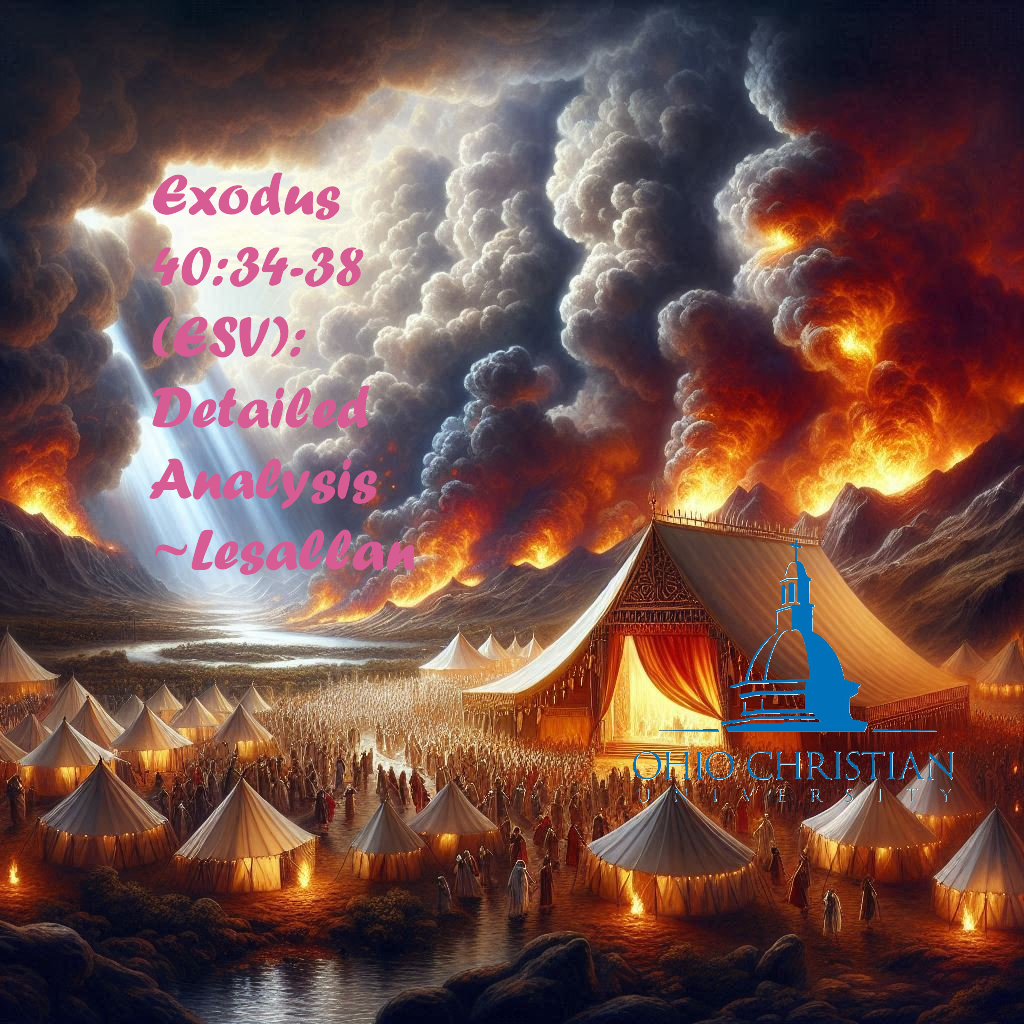September 23, 2024

Exodus 40:34-38 (ESV): Detailed Analysis
Version: ESV
initial Observations & Questions
- A cloud covered the meeting tent, and the Tabernacle was filled with the Lord’s glory (Exodus 40:34, ESV).
- What is the significance of the cloud covering the tent of meeting and the glory of the Lord filling the Tabernacle?
- Moses could not enter the meeting tent due to the cloud’s settling, as the glory of the Lord filled the Tabernacle (Exodus 40:35, ESV).
- Why was Moses unable to enter the tent for the meeting when the cloud settled on it?
- Throughout all their journeys, whenever the cloud was taken up from over the Tabernacle, the people of Israel would set out (Exodus 40:36, ESV).
- How did the movement of the cloud guide the Israelites in their journeys?
- If the cloud was not taken up, they did not set out until the day it was taken up (Exodus 40:37, ESV).
- What does this indicate about the Israelites’ dependence on God’s guidance?
- The Lord’s cloud was over the Tabernacle during the day, and at night, there was a fire in it, visible to all the houses of Israel throughout all their travels (Exodus 40:38, ESV).
- What is the significance of the cloud by day and fire by night for the Israelites?
- How do the cloud and fire in Exodus 40:34-38 (ESV) reflect God’s relationship with the Israelites?
Structure
Exodus 40:34-38 (ESV) marks the culmination of the Book of Exodus, symbolizing the completion of the Tabernacle and the fulfillment of God’s promise to live among His people. This passage vividly depicts God’s tangible presence with the Israelites, represented by the cloud and fire that had guided them since their exodus from Egypt. The image of the cloud and the glory of the Lord filling the tabernacle is a powerful symbol of God’s approval of the tabernacle and His unwavering commitment to be with His chosen people. This significant event strengthens the bond between God and the Israelites and foreshadows the more profound spiritual truth of God’s enduring presence with His people throughout history.
The passage from Exodus (Exodus 40:34-38, ESV) provides a powerful depiction of God’s presence and guidance among the Israelites. It can be divided into two main sections, each illustrating different aspects of this divine presence. The first section, verses 34-35, vividly describes how a cloud covers the meeting tent and the glory of the Lord fills the tabernacle, signifying the overwhelming presence of God and preventing Moses from entering. In the second section, verses 36-38, the movement of the cloud dictates the Israelites’ journey, symbolizing God’s direct guidance and control over their movements. The imagery of the cloud by day and fire by night is a constant reminder of God’s continual presence and guidance for the Israelites throughout their journey. This passage highlights the significance of God’s presence among His people and emphasizes His active involvement in their lives, providing them with both physical and spiritual guidance.
I. The Glory of the Lord Fills the Tabernacle (Exodus 40:34-35, ESV)
A. The Cloud Covers the Tent of Meeting (Exodus 40:34, ESV)
B. Moses Prevented from Entering (Exodus 40:35, ESV)
II. God’s Guidance Through the Cloud and Fire (Exodus 40:36-38, ESV)
A. The Cloud’s Movement Dictates the Journey (Exodus 40:36-37, ESV)
B. Symbol of God’s Continual Presence (Exodus 40:38, ESV)
Words & Phrases
“Cloud” (Exodus 40:34, ESV)
What is the significance of the cloud in this context?
The cloud represents God’s presence and guidance. It had been a visible manifestation of God’s presence since the Israelites left Egypt (Exodus 13:21-22). The cloud covering the tent of the meeting signifies God’s approval and dwelling among His people.
What is the Hebrew meaning of the cloud?
The cloud represents God’s presence and guidance. It had been a visible manifestation of God’s presence since the Israelites left Egypt (Exodus 13:21-22, ESV). The cloud covering the tent of the meeting signifies God’s approval and dwelling among His people.
“Tent of meeting” (Exodus 40:35, ESV)
Why is the tent of meeting significant in this passage?
The tent of meeting was where God would meet with Moses and the Israelites. It symbolizes God’s willingness to be accessible to His people and to guide them. The fact that Moses could not enter when the cloud settled on it emphasizes God’s holiness and overwhelming presence.
What is the Hebrew meaning of “Tent of Meaning” (Exodus 40:35, ESV)?
The tent of meeting was where God would meet with Moses and the Israelites. It symbolizes God’s willingness to be accessible to His people and to guide them. The fact that Moses could not enter when the cloud settled on it emphasizes God’s holiness and overwhelming presence.
“Glory” (Exodus 40:34, ESV)
How does the glory of the Lord relate to the cloud and the tabernacle?
The glory of the Lord filling the tabernacle signifies God’s presence and His approval of the tabernacle as His dwelling place. It also reflects God’s majesty and holiness, which is so overwhelming that even Moses could not enter.
What is the Hebrew meaning of “Glory” and its significance (Exodus 40:34, ESV)?
Hebrew Meaning: The Hebrew word for “glory” is כָּבוֹד (kabowd), which means glory, honor, or splendor. The glory of the Lord filling the tabernacle signifies God’s presence and His approval of the tabernacle as His dwelling place. It also reflects God’s majesty and holiness, which is so overwhelming that even Moses could not enter.
“Fire” (Exodus 40:38)
What is the significance of the fire by night?
The fire by night provided light and protection for the Israelites. It also symbolized God’s presence and guidance, ensuring the Israelites could see and follow God’s direction even in the darkness.
What is the Hebrew word and meaning for “Fire” (Exodus 40:38, ESV)?
Hebrew Meaning: The Hebrew word for “fire” is אֵשׁ (esh), which means fire.
Significance: The fire by night provided light and protection for the Israelites. It also symbolized God’s presence and guidance, ensuring the Israelites could see and follow God’s direction even in the darkness.
Summary, correlation, & application
The main point of this passage is that God’s presence, symbolized by the cloud and fire, filled the Tabernacle, signifying His approval and commitment to dwell among and guide His people.
In the book of Exodus (Exodus 40:34-38, ESV), the passage describes the cloud covering the tent of meeting and the glory of the Lord filling the Tabernacle, which prevented Moses from entering. This event symbolizes the powerful presence of God among his people. The movement of the cloud, guiding the Israelites’ journeys through the wilderness, further emphasizes God’s active presence and leadership. This divine guidance provided the Israelites with a tangible sign of God’s presence and direction as they journeyed through the wilderness toward the promised land.
This passage parallels other parts of Scripture where a cloud or fire symbolizes God’s presence. For instance, in the book of Exodus, God guided the Israelites with a pillar of cloud by day and fire by night (Exodus 13:21-22, ESV). Additionally, in 1 Kings, the cloud filled the newly built temple of Solomon, signifying God’s presence among His people (1 Kings 8:10-11, ESV). These instances foreshadow the New Testament, where God’s presence is manifested through the Holy Spirit, as depicted in Acts 2:1-4 (ESV). This continuity throughout Scripture emphasizes the unchanging nature of God’s presence and His ongoing relationship with His people.
Interpreted within its canonical context, this passage serves as a powerful reassurance of God’s continual presence and guidance in the lives of believers. On a personal level, it can be a comforting reminder of God’s unwavering faithfulness and His steadfast commitment to lead individuals through life’s journey, no matter the challenges or uncertainties that may arise. Furthermore, for local churches and the broader Christian community, it underscores the importance of seeking and diligently following God’s guidance in all decisions and actions. This passage encourages believers to remain steadfast in their faith, to seek divine wisdom in times of decision-making, and to trust in God’s sovereign guidance as they navigate the complexities of life.
Further questions
- How does the concept of God’s presence in the Tabernacle compare to the New Testament understanding of God’s presence through the Holy Spirit?
- What lessons can contemporary believers learn from the Israelites’ dependence on God’s guidance through the cloud and fire?



4 Comments
temp mails free · September 25, 2024 at 7:46 am
I really like reading through a post that can make men and women think. Also, thank you for allowing me to comment!
guitar · September 30, 2024 at 9:26 am
I was recommended this website by my cousin I am not sure whether this post is written by him as nobody else know such detailed about my trouble You are amazing Thanks
Family Dollar · September 30, 2024 at 7:06 pm
Family Dollar Pretty! This has been a really wonderful post. Many thanks for providing these details.
Pink Withney · October 1, 2024 at 7:06 am
Pink Withney I just like the helpful information you provide in your articles
Comments are closed.